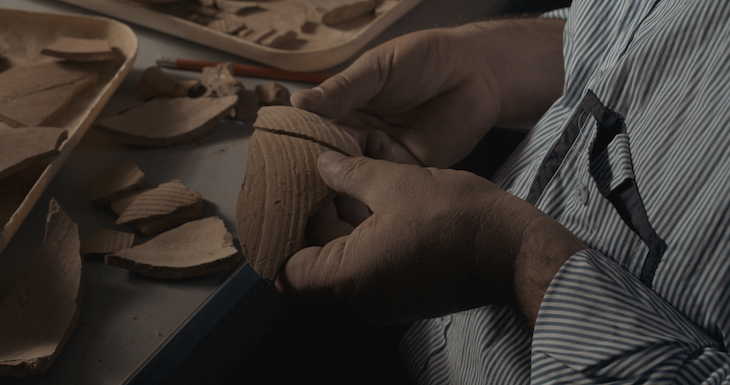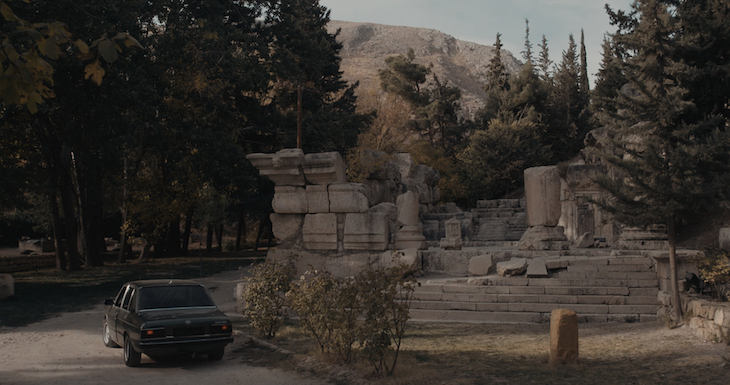A few minutes into Maeve Brennan’s new film, The Drift, on show at the Chisenhale Gallery, London, Fakhr El Fakhry slowly approaches a Roman temple, its mammoth walls obscured by pale foliage that rustles quietly in the breeze. He chooses each step deliberately, navigating the contemporary landscape with the same respect he affords the centuries-old ruins laid out before him. The lens stays put, and as El Fakhry fades into the foliage, he pauses, turns, and beckons Brennan, and her audience, to follow him.
(All images) Maeve Brennan, The Drift (2017). Produced by Chisenhale Gallery, London and Spike Island, Bristol. Commissioned by Chisenhale Gallery; Spike Island; The Whitworth, The University of Manchester; and Lismore Castle Arts, Lismore. Courtesy of the artist.

It’s an exceptionally ordinary moment between guide and visitor, and one with enough silence to get our wheels turning – is this a documentary? What kind of relationship is unfolding on the screen? Is Fakhry, a bit uncertain as to the increasing distance between himself and the camera, in on the plan? These questions might never be answered outright, but the brilliance of The Drift is hidden in the gradual mechanisms that keep Brennan’s meditative, 51-minute film slowly advancing forward.
Fakhry is one of three main characters chosen by Brennan to illuminate contemporary Lebanon’s shifting object economies, revealing the ways historical value can change in the face of conflict, and examining our varied roles in cultural preservation. In other words, she is tackling some cumbersome and complicated themes, especially in light of Lebanon’s geographic role as receptacle for the illicit antiquities trade as the Syrian war continues to the north. Wisely, she allows for the mountainous landscape to do most of the talking, orchestrating beautifully staged scenes after months of documentary research, interspersed with snippets of conversation from her interviewees.

Billed as ‘The Gatekeeper’, Fakhry has lived in Niha, a village in the Beqaa valley, his entire life, and inherited the guardianship of the area’s Roman temples from his father around 43 years ago. ‘I know the place of every stone,’ he tells us, describing with reverence the time and care it takes to restore and preserve the temples, where some structures date back to the 1st century AD. Even after all these years, he remains equally in awe and in service of the ruins, repairing the wounds of conflicts both ancient and recent, describing the damage incurred on his watch during the Lebanese Civil War in the years between 1975 and 1990.

Hashem Ghali, an archaeological conservator at the American University of Beirut, also works in ruins – the kind you can hold in your hand. In the soft light of his basement workshop, surrounded by shards of pottery, Brennan films him at work, repairing jugs, pots, and handles that were excavated after the civil war: handheld witnesses to destruction. In these scenes, Ghali uses basic tools – toothbrushes, extra-strength superglue – to clean and study the fractures in an attempt to unite the fragments. The drawn-out portrait is one of patience, quiet frustration and small victories, linking these two men (one in the field, one in the workshop) in a continuing blur of documentary filmmaking and artistic study of restoration and survival.
The title of the film, however, is a cheeky nod to ‘The Mechanic’, Brennan’s third ‘guide’. Mohammed Zaytoun is a young BMW-obsessive from the village of Britel, whose car-part scavenging doesn’t seem so removed from the preservation work of Fakhry and Ghali. He is a sports car conservator, touring the dusty landscape, retrieving disparate parts, and under Brennan’s direction, making repairs in the shadow of mountains and ruins.

Cigarette hanging from his lips, he describes the nearby outlaw road that runs from Syria, and tests the limits of his clutch by peeling out, drifting and rallying in circles. In a darkly comic moment, he stops to admire the wheels on the car-bombed memorial to Ali Saleh, a Hezbollah leader who was assassinated by Israeli army in 2003. ‘God have mercy on his soul’ he says almost wistfully. ‘But God, those wheels are brand new.’
Each of these men relate to destroyed objects in their own ways and their own time, their physical relationships to the remnants of war fleshed out by Brennan’s unhurried camerawork. Like the mountain ranges in her wide-angle shots of Zaytoun’s BMW, conflict hovers over all of them, but for the different generations, it’s a question of which conflict: where the older men shake their heads at the lengthy civil war, Zaytoun speaks about the Hezbollah-Israeli conflict of recent years. Two cameos by a young antiquities smuggler and an older antiquities collector help drive home generational attitudes towards the value of historical objects – in the midst of cyclical violence, objects and humans continue to drift.

Straddling the line of artistic director and documentarian, Brennan leaves ample room for contemplation as the film unfolds, and part of the film’s success lies in these quiet moments where we can puzzle over coincidences and connections. Steadily shifting from one story to another, the title of the film becomes as layered as the landscape on screen. As Zaytoun says toward the end of the film, speaking for all of them (Brennan included): ‘We must leave our mark.’

‘Maeve Brennan: The Drift’ is at the Chisenhale gallery, London, until 4 June.



